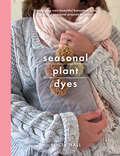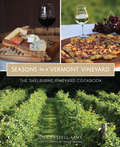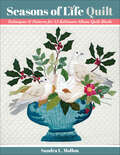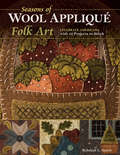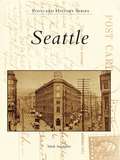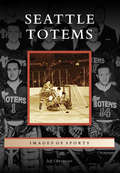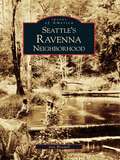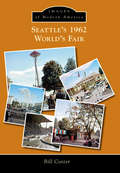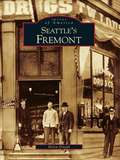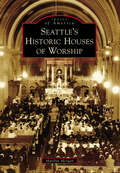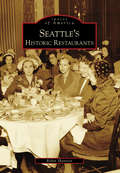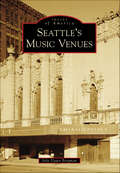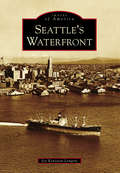- Table View
- List View
Seasonal Living with Herbs: How to Grow, Harvest, Preserve and Use Herbs Year Round
by Jess ButtermoreEnhance Your Home and Health with Seasonal HerbsThe ultimate guide to seasonal herbs, Seasonal Living with Herbs is a transformative book that explores the medicinal, culinary, and crafting uses of herbs.Unlock the full potential of seasonal herbs. This is your go-to resource for discovering the extraordinary benefits of nature's bounty. Learn how to preserve herbs and harness their medicinal properties, explore creative ways to use herbs in your everyday life, and cultivate a deeper connection to the natural world.Discover the secrets of herbal abundance with Seasonal Living with Herbs—a comprehensive book that invites you to embrace the beauty and benefits of seasonal herbs. With guidance for growing and caring for herbs in every season, you'll learn to harness their full potential. Delight in the herbal spotlights specific to each season, savor the flavors of seasonal recipes, and create stunning crafts that celebrate the natural world. From cultivating your own herb garden to preserving their essence, this book empowers you to infuse your daily life with the magic of herbs.Inside, you'll find:Herbal spotlights highlighting the unique properties of seasonal herbsRecipes using herbs that showcase their flavors and aromasFrom your garden to your craft projects inspired by the beauty of herbsStep-by-step instructions on how to preserve herbs and their benefitsIf you enjoyed books on how to use herbs like The Herbal Medicine-Maker's Handbook, The Herbal Kitchen, or The Healing Kitchen, you'll love Seasonal Living with Herbs.
Seasonal Plant Dyes: Creating Year Round Colour From Plants, Beautiful Textile Projects (Crafts Ser.)
by Alicia Hall“Fascinating and well-illustrated . . . Hall has in the main selected plants which do not require excessively arcane procedures to produce exquisite colors.” —AboutMyGenerationThis beautifully illustrated book takes you on a botanical journey through the year, showing you how to create colorful and environmentally friendly plant dyes. You’ll learn sustainable methods of growing and harvesting plants; the tools and techniques required to extract dye; which fabrics and yarns to choose; and the simple method of using soy milk as a fixative, to ensure rich and long-lasting colors. The book includes easy-to-follow tutorials explaining how to make four stunning pieces using seasonal plant dyes: a linen cushion cover, embroidered picnic blanket, hot water bottle cozy, and quilt.“The new book Seasonal Plant Dyes by Alicia Hall walks us through the process featuring plants to use at their peak in spring, summer, autumn, and winter to create an array of gorgeous colors and textures only natural dyes can achieve.” —Empress of Dirt“Some amazing facts about plants . . . Nature fools us all in to thinking yellow flowers would produce various shades of yellow dyes and all leaves would give green dyes of different hues. This is not so! Who would have believed for instance that a dark purple Buddleia flower would produce a dye of buttercup yellow. 104 pages of fascinating information and I can’t wait to try my first dye! A well written book that’s a delightful and interesting read.” —For the Love of Books
Seasonal Slow Knitting: Thoughtful Projects for a Handmade Year
by Hannah Thiessen“Thiessen’s new book is all about promoting creativity at a slower pace, offering advice on finding the time and space to knit in a restful, calming way.” —The Knitter Slow Knitting introduced crafters to a process of more mindful making through five basic tenets: source carefully, make thoughtfully, think seasonally, experiment fearlessly, and explore openly. Now, this seasonal approach encourages knitters to delve deeper into those concepts, applying them to everyday making through a series of essays, projects, and patterns that explore the life of a knitter throughout the year. Organized similarly to a seasonal planting guide or farmer’s almanac, each chapter and section is designed to identify and encourage small ways that knitters may begin to employ noticeable change: organizing your yarn stash, carving out time for knitting, and starting on that baby blanket in a timely manner. The ideas explored here add up to a fuller, more mindful year, all through the joyful experience that is knitting.
Seasoned Speech: Rhetoric in the Life of the Church
by James E. Beitler IIIThe Christian faith depends to a great degree on persuasion. In one of his letters to early Christians, the apostle Paul wrote, "Let your speech always be gracious, seasoned with salt, so that you may know how you ought to answer everyone" (Col. 4:6). Yet rhetoric—the art of persuasion—has been largely ignored by most Christians. In this book, James Beitler seeks to renew interest in and hunger for an effective Christian rhetoric by closely considering the work of five beloved Christian communicators: C. S. Lewis, Dorothy L. Sayers, Dietrich Bonhoeffer, Desmond Tutu, and Marilynne Robinson. Moreover, he situates these reflections within the Christian liturgical seasons for the essential truths they convey. These writers collectively demonstrate that being a master of rhetoric is not antithetical to authentic Christian witness. Indeed, being a faithful disciple of Christ means practicing a rhetoric that beneficially and persuasively imparts the surprising truth of the gospel. It means having seasoned speech.
Seasons in a Vermont Vineyard: The Shelburne Vineyard Cookbook (American Palate)
by Lisa Cassell-Arms Photographs By SeaverVermont is a food lover’s paradise. From its verdant and fertile farmland, regional specialties are emerging. We have an abundant selection of locally raised meats, poultry, produce and fruits, as well as world-class artisanal cheeses, award-winning spirits, ciders, beers and, of course, wine. Shelburne Vineyard is recognized as a pioneer in cold-climate winemaking, producing expertly crafted wines from Vermont and regionally grown hybrid grapes. With original mouthwatering recipes crafted especially for this new edition, this book celebrates a generation of outstanding wines and the affinity of food and wine produced from the same northern terroir.
Seasons of Connecticut: A Year-Round Celebration Of The Nutmeg State
by Diane SmithSeasons of Connecticut is a beautiful, four color celebration of the Nutmeg state by a veteran television and radio reporter who has told the stories of the people and places of Connectiut for twenty years. The sixty stories included in this book will make people feel good about living in Connecticut, and make others want to visit, revealing the beauty and the personality of the state throughout the year.
Seasons of Life Quilt: Techniques & Patterns for 13 Baltimore Album Quilt Blocks
by Sandra L. MollonFall in love with Baltimore Album quilts Take on your next quilting feat with a champion quilt! From expert quilter Sandra Mollon, recreate the “Seasons of Life” quilt, which is now a part of a permanent collection of the National Quilt Museum in Paducah, Kentucky. Learn techniques for incorporating unusual fabrics, creating dimensional flowers, as well as shading with inks and embellishing blocks. In true “Baltimore” style, each of the 13 blocks features a different tribute to nature in highly stylized fashion: baskets, wreaths, flowers, leaves and vines, and small garden or forest animals. Appliqué each block for your very own stunning creation. Learn tons of techniques with appliqué, embroidery, ribbon work, beading, and more! Includes full-sized pattern and instructions to the award-winning “Seasons of Life” quilt Make 13 unique blocks with a pieced and scalloped border encircling the blocks
Seasons of Maine
by William Hubbell Jean HubbellBill Hubbell writes in his preface that entering Maine is not like crossing into other states: "A few miles after having passed the border, a subtle awareness sneaks in. The woods seem deeper, the sky higher, the air fresher, the spaces wider, the distances longer. Maine is an expansive place--for the spirit, for the body, for the soul."Here, in more than a hundred and forty wonderful color images, lifetime professional photographer Hubbell has captured the very essence of his home state in all four seasons. This is not an "art" book but a tribute to the diverse places and ever-changing character that make Maine special. Accomplishing this goal involved an exhaustive crisscrossing of the state, requiring fourteen months, thirty-two thousand miles, and six hundred and forty rolls of film.The result is a feast for the eyes. Anyone who has visited or lived in Maine will cherish these photographs and marvel at the skill of the man who took them. Here are Portland's Old Port, resplendent in its Christmas finery; Penobscot Bay, plied by graceful windjammers; the Machias Blueberry Festival and its hands-off pie-eating contest; isolated Eastern Egg Rock and its colorful puffins; Baxter State Park, crowned by majestic Katahdin; and much, much more.Whether you delight in sights that you've never had a chance to see, or relive the memory of places that instantly became favorites, Bill Hubbell's vision of Maine is sure to please for years to come.
Seasons of Wool Appliqué Folk Art: Celebrate Americana with 12 Projects to Stitch
by Rebekah L. SmithEnjoy wool appliqué all year round with 12 seasonal projects from the bestselling author of Wool Appliqué Folk Art.Rebekah L. Smith’s Americana aesthetic, although very true to early decorative arts, will look great in many homes today. Presented in a lovely antique color palette, these simple and elegant projects include a journal cover, pillow cover, wall hangings, storage boxes, table rug, and more, perfect for your home or to give as gifts. Includes a basics chapter and an updated chapter on the collection, storage, and use of wool.• Beginner-friendly projects with downloadable full-size patterns, ranging from a pillow and blanket carrier to a tea cozy and table runner• Includes a beautiful styled photo of each project, as well as detail shots to show the gorgeous stitching• Award-winning folk artist Rebekah Smith’s historically inspired designs are perfect for traditional quilters, textile artisans, rug hookers, and anyone who appreciates her signature style
Seasons of the Moon: Folk Names and Lore of the Full Moon
by Michael CarabettaFrom Strawberry to Dragon, Harvest to Storm, the full moon is known by many names around the world and across the seasons, and each name has a story behind it. This beautiful photographic celebration of our closest celestial neighbor captures the visual wonder and the connection we feel to the moon. Including three dozen folk names and short evocative explanations drawn from Native American, Inuit, Celtic, medieval English, Hindu, Chinese, Japanese, and pagan cultures, Seasons of the Moon presents an inspired visual pairing for each, taken in the month the folk name represents. This portrait of our eternal fascination with the moon is a welcome companion as we look to the sky throughout the seasons.
Seattle (Postcard History Series)
by Mark SundquistThe Puget Sound region was inhabited by Native Americans for thousands of years before settlers arrived. After initially landing at Alki Beach in West Seattle, the Denny Party established a settlement on the eastern shores of Elliott Bay in 1852. For years, the cultural and commercial life centered around Yesler's Wharf and Sawmill. The city grew rapidly following the 1870s after the discovery of coal in the Cascade foothills. The entire commercial district was incinerated in the Great Seattle Fire of 1889, but it was quickly rebuilt out of enduring brick and stone. The city stumbled economically following the Panic of 1893, but it recovered after the Klondike Gold Rush began in 1897. By the 1909 Alaska-Yukon-Pacific Exposition, Seattle was the undisputed leader in the Pacific Northwest.
Seattle Fire Department (Images of America)
by Richard SchneiderOn June 6, 1889, 25 city blocks of the city of Seattle and every mill, wharf, and warehouse from Union to Jackson Streets were consumed in a firestorm that started when a glue pot tipped over. Both of the Seattle firehouses burned in the devastating inferno, and the result was the end of the volunteer fire department and the formation of the Seattle Fire Department. Seattle got its first fireboat in 1891, at a little fire station at the foot of Madison Street and Alaskan Way, and the department depended on horse-drawn equipment until 1924, when the last horse was retired. Boasting the oldest continuously operating medic unit in America, today's Seattle Fire Department is a proud organization with 34 fire stations and more than 1,000 uniformed personnel.
Seattle Radio
by John F. SchneiderSeattle's first radio broadcast aired in 1919, and over the next 90 years, the city drew national attention for its collection of flamboyant and sometimes quirky broadcast impresarios and performers. The parade of people that passed in front of and behind the Puget Sound microphones included a big-time bootlegger and his wife, two embezzling bank managers, a political campaign manager, and a lumber mill baron's daughter. Two local radio men started with practically nothing and built their own successful Northwest station groups. An underpaid novice Seattle radio announcer went on to become the dean of the country's television newscasters. A 1950s disc jockey used acrobatic publicity stunts to draw an audience for his station. A guitar-strumming radio singer capitalized on his fame to build a chain of restaurants. And the founder of a Seattle "free form" FM radio station went on to build a network of community FM stations around the country, making him "The Johnny Appleseed of Community Radio."
Seattle Totems
by Jeff ObermeyerBefore major-league professional sports came to the Northwest, Seattle had a rich minor-league sports history. In the winter, Saturday afternoons were for college football, but the nights were for hockey. From the late 1950s through the mid-1970s, hockey could only mean one thing--the Seattle Totems. Led by Guyle Fielder, the Totems won three Western Hockey League (WHL) championships as they skated and fought against their rivals. Grab a seat and get ready to learn about Seattle's hockey history from the Seattle Metropolitans, the first American team to win the Stanley Cup, through the Totems as they battle their WHL foes and even the Russian National Team in pursuit of hockey glory.
Seattle's Ravenna Neighborhood
by Ann WendellFor centuries, Native American tribes lived peacefully along the trout-filled stream in a ravine that would later become part of northeastern Seattle. In 1887, the Reverend Beck disembarked from the Seattle Lake Shore & Eastern Railroad and, in this same area, bought 300 lushly forested acres that he turned into a township and park, both called Ravenna. The town was only three and a half miles from the city center and soon boasted a flour mill and a finishing school. The park itself, with its giant trees, mineral springs, fountains, and music pavilion, soon became a major attraction and well worth the 25¢ admission. Eventually the timber was harvested and the school replaced by the university. Today the park remains a haven of serenity and the stream once again runs through it.
Seattle's 1962 World's Fair
by Bill CotterWhen the United States entered the 1960s, the nation was swept up in the Space Race as the United States and the Soviet Union competed for supremacy in rocket and satellite technologies. Cities across the country hoped to attract new aerospace companies, but the city leaders of Seattle launched the most ambitious campaign of all. They invited the whole world to visit for the 1962 Seattle World's Fair, and more than nine million people took them up on the offer. A colorful collection of exhibits turned 74 acres of rundown buildings into a futuristic wonderland where dozens of countries and companies predicted life in the future. The entire city was transformed with the addition of the soaring Space Needle and the futuristic monorail. When the fair ended, the site became a complex of parks and museums that remains a vibrant part of Seattle city life today.
Seattle's Fremont
by Helen DivjakLovingly labeled by locals as the "Center of the Universe," Fremont is one of Seattle's most eclectic and dynamic neighborhoods. Having been little more than lush primeval forest just over a century ago, the area grew to be the home of the city's blue-collar workers, a bohemian haven for local artists, and now a thriving urban mecca of bars, restaurants, hip boutiques, and art studios that cater to the worldly aware. Most recently, Fremont has become the address of hightech giants like Adobe. It continues to evolve, reflectingthe changes in industry that have contributed to Fremont's reputation as an urban area on the cutting edge.
Seattle's Green Lake
by Brittany WrightDiscovered in 1855, Green Lake has been an essential feature within Seattle's distinctive juxtaposition of landscape architecture and urban expansion, providing recreation and community focus for the last 150 years. Named after the persistent algae bloom that still occurs, the lake is a valuable natural landmark at the center of a neighborhood in transition, and its past is threaded with tenacious organizations and ambitious individuals. From its first homesteader, Erhart "Green Lake John" Saifried, to the vision of the Olmsted brothers, from Guy Phinney's menagerie to the triumph and tragedy of Helene Madison, from ice-skating to the Aqua Follies, this broad collection of vintage images illustrates a bygone era and provides a unique perspective on community values and ecological struggle.
Seattle's Greenwood-Phinney Neighborhood
by Ted PedersenThe beauty of Seattle's Greenwood lies in its contrasts. It is an old-fangled neighborhood with a trendy edge, where coffee shops and espresso bars mix with caf©s, shops, and galleries patronized by antique hounds. The locals dub it "Seattle's hidden treasure." Just south, Phinney occupies a high ridge that rises from the western shore of Green Lake. The neighborhood owes its name to Guy Phinney, a wealthy immigrant from Nova Scotia who developed the private estate that became Woodland Park. Together these neighborhoods have forged a common bond, illustrated by the formation of the Greenwood-Phinney Chamber of Commerce. The area hosts a world-class zoo and is home to the only Tibetan Buddhist monastery in the world outside of Tibet.
Seattle's Historic Hotels (Images of America)
by Robin ShannonMary Ann Conklin, also known as "Madame Damnable," ran Seattle's first hotel, the Felker House, which burned to the ground in the Great Seattle Fire of 1889. The Rainier Hotel was erected quickly following the Great Seattle Fire but razed around 1910. The Denny Hotel, an architectural masterpiece later known as the Washington Hotel, was built in 1890 but torn down in 1907 during the massive regrade that flattened Denny Hill. Upon opening in 1909, the Sorrento Hotel was declared a "credit to Seattle" by the Seattle Times. The Olympic Hotel was the place for Seattle's high society throughout the 1920s. The Hotel Kalmar was a workingman's hotel built in 1881 and was razed for the Seattle tollway. The Lincoln Hotel was destroyed by a tragic fire in 1920, along with its rooftop gardens. The famous and grand Seattle Hotel in Pioneer Square was replaced by a "sinking ship" parking garage, thus sparking preservationists to band together to establish Pioneer Square as a historic district.
Seattle's Historic Houses of Worship (Images of America)
by Marilyn MorganAs Seattle grew in the mid-1800s, the increase in families settling in the area created a need for churches. Seattle First Church was established in 1853 and by 1901 Seattle had 112 churches; today, there are less than 20 of these churches still in existence. Seattle’s Historic Houses of Worship explores many of these churches, examining how they have survived over 100 years, while still going strong today. Churches have guided the Seattle community through the great Seattle fire, world wars, internment camps, the assassination of a president, and the protests of the civil rights era.
Seattle's Historic Restaurants
by Robin ShannonSeattle's Historic Restaurants depicts an era of nostalgia and romanticism, and highlights historic photographs of restaurants, postcards, and menus. From 1897 to 1898, thousands of so-called stampeders came through Seattle on their way to the Klondike goldfields. Hungry stampeders could purchase a meal at the Merchant's Café (the oldest café in Seattle) or one of the many restaurants nearby. For the next 25 years, those who made it rich in Seattle were the restaurateurs, shop owners, and real estate owners. Famous local landmarks such as the Space Needle, Mount Rainier's Paradise Camp, Snoqualmie Falls, and the Empress Hotel are still here, but their menus and clientele have changed over the years. Local haunts like Ivar's Acres of Clams, The Dog House, Andy's Diner, Clark's Restaurants, Coon Chicken Inn, Frederick and Nelson's Tea Room, The Wharf, Von's, The Purple Pup, and the Jolly Roger are just a few of the restaurants featured within.
Seattle's Music Venues (Images of America)
by Jolie Dawn BergmanThe varieties of music venues in Seattle have been as vital and vibrant for the people of the Emerald City as the genres that have graced these famous halls. These houses of music have nurtured the entertainment legacy of this region. Each holds a beautiful, haunting, and unique history that has helped shape the Pacific Northwest�s musical culture, which, in turn, has helped shape our community. Out of the ashes of the Great Seattle Fire of 1889, the vaudeville age took Seattle by storm. The cultural and community centers harmonized with operas and symphonies. From the 1962 World�s Fair to world-famous street musicians, Seattle�s Music Venues will take the reader on a pictorial journey through 100 years of images compiled from the photographic collections of the Seattle Public Library, Seattle Municipal Archives, Library of Congress, and the author�s personal collection.
Seattle's Waterfront
by Joy Keniston-LongrieSeattle's waterfront has served as a central hub for people, transportation, and commerce since time immemorial. A low natural shoreline provided the Duwamish-Suquamish people with excellent canoe access to permanent villages and seasonal fishing camps. High bluffs served as a sacred place for tribal members' final journey to the spirit world. When the first settlers arrived in the 1850s, Seattle's shoreline began to change drastically. Emerald hills covered with dense forests were logged for timber to make way for the new city. As time passed, Seattle constructed a log seawall, wooden sidewalks, wharfs, buildings, streets, railroad trestles, and eventually, a massive concrete viaduct over the original aquatic lands, changing the natural environment to a built environment. Today, Seattle's shoreline continues to change as the city demolishes the viaduct, rebuilds the seawall, and creates an inviting new waterfront that all will enjoy for generations to come.
Sebastian and Crawford Counties
by Ray Hanley Steven HanleySebastian and Crawford Counties are among Arkansas's most historic areas with their location on what was once the edge of the frontier. In this book, the authors capture the transition of both the large and the small communities from the 1800s into the middle of the 20th century through historic postcards. With carefully researched interpretation of the images, the book offers a fascinating walk through time along the streets of bustling Fort Smith and Van Buren, tiny hamlets, and even a trip up historic Highway 71 to Mount Gaylor.

